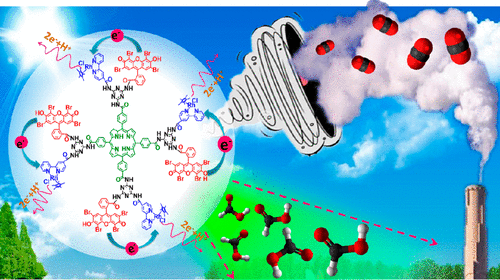当前位置:
X-MOL 学术
›
ACS Catal.
›
论文详情
Our official English website, www.x-mol.net, welcomes your
feedback! (Note: you will need to create a separate account there.)
Enhanced Solar Energy Harvest and Electron Transfer through Intra- and Intermolecular Dual Channels in Chlorosome-Mimicking Supramolecular Self-Assemblies
ACS Catalysis ( IF 11.3 ) Pub Date : 2018-10-10 00:00:00 , DOI: 10.1021/acscatal.8b03105 Xiaoyuan Ji 1, 2, 3 , Jie Wang 1, 4 , Yong Kang 1 , Lin Mei 2 , Zhiguo Su 1 , Shaomin Wang 4 , Guanghui Ma 1 , Jinjun Shi 3 , Songping Zhang 1
ACS Catalysis ( IF 11.3 ) Pub Date : 2018-10-10 00:00:00 , DOI: 10.1021/acscatal.8b03105 Xiaoyuan Ji 1, 2, 3 , Jie Wang 1, 4 , Yong Kang 1 , Lin Mei 2 , Zhiguo Su 1 , Shaomin Wang 4 , Guanghui Ma 1 , Jinjun Shi 3 , Songping Zhang 1
Affiliation

|
The direct connection between a photosensitizer and an electron mediator, achieved by a precise arrangement based on chlorosome, provides photosynthetic bacteria the maximum efficiency in solar energy conversion. Herein, this study reports the fabrication of a biomimicking chlorosome for biocatalyzed artificial photosynthesis through self-assembly of simple molecules to functional systems. TCPP/EYx/Rh8–x macromolecules, synthesized through a sequential amidation reaction of porphyrin (TCPP), eosin Y (EY), and [Cp*RhCl2]2, were found to self-assemble into chlorosome-mimicking supramolecular assemblies through noncovalent interactions. Intra- and intermolecular dual channels for enhancing electron transfer were constructed in TCPP/EYx/Rh8–x supramolecular assemblies. In addition, the energy band structure of TCPP/EY4/Rh4 supramolecular assemblies also made a perfect coordination with oxidation and reduction potentials of an electron donor and NAD+, which led to a fast and oriented electron transfer along the electron donor, TCPP/EY4/Rh4 and NAD+. In comparison with a system using free components, the yield of NADH photoregeneration was improved from 15% to 91% by TCPP/EY4/Rh4 supramolecular assemblies; when this NADH photoregeneration process was coupled with dehydrogenases, 38 μM methanol was synthesized from CO2 after 2 h of visible light irradiation, which was about 12-fold higher than that obtained using free components. The chlorosome-inspired TCPP/EYx/Rh8–x supramolecular assemblies with intra- and intermolecular electron transfer dual channels represents a landmark for implementing highly effective solar energy conversion and selective methanol synthesis from CO2 in a green and sustainable manner.
中文翻译:

在模拟染色体的超分子自组装体中通过分子内和分子间双通道增强太阳能收集和电子转移
光敏剂和电子介体之间的直接连接(通过基于氯脂质体的精确布置实现)为光合细菌提供了太阳能转换的最大效率。本文中,这项研究报告了通过将简单分子自组装为功能性系统,制造用于生物催化的人工光合作用的仿生氯仿体的制备方法。TCPP / EY x / Rh 8– x大分子,通过卟啉(TCPP),曙红Y(EY)和[Cp * RhCl 2 ] 2的顺序酰胺化反应合成被发现通过非共价相互作用自组装成模仿氯仿的超分子组装体。在TCPP / EY x / Rh 8– x超分子组装体中构建了用于增强电子传递的分子内和分子间双通道。此外,TCPP / EY 4 / Rh 4超分子组装体的能带结构还与电子供体和NAD +的氧化和还原电势完美配合,从而导致沿电子供体TCPP的快速定向电子转移/ EY 4 / Rh 4和NAD +。与使用游离组分的系统相比,TCPP / EY 4 / Rh 4超分子组装将NADH光再生的产率从15%提高到91%。当该NADH光再生过程与脱氢酶偶联时,在可见光照射2 h后,由CO 2合成了38μM甲醇,这比使用游离组分得到的甲醇高约12倍。具有内部和分子间电子转移双通道的,受氯仿启发的TCPP / EY x / Rh 8– x超分子组装体,是实现绿色高效且可持续的高效太阳能转化和从CO 2选择性合成甲醇的里程碑。
更新日期:2018-10-10
中文翻译:

在模拟染色体的超分子自组装体中通过分子内和分子间双通道增强太阳能收集和电子转移
光敏剂和电子介体之间的直接连接(通过基于氯脂质体的精确布置实现)为光合细菌提供了太阳能转换的最大效率。本文中,这项研究报告了通过将简单分子自组装为功能性系统,制造用于生物催化的人工光合作用的仿生氯仿体的制备方法。TCPP / EY x / Rh 8– x大分子,通过卟啉(TCPP),曙红Y(EY)和[Cp * RhCl 2 ] 2的顺序酰胺化反应合成被发现通过非共价相互作用自组装成模仿氯仿的超分子组装体。在TCPP / EY x / Rh 8– x超分子组装体中构建了用于增强电子传递的分子内和分子间双通道。此外,TCPP / EY 4 / Rh 4超分子组装体的能带结构还与电子供体和NAD +的氧化和还原电势完美配合,从而导致沿电子供体TCPP的快速定向电子转移/ EY 4 / Rh 4和NAD +。与使用游离组分的系统相比,TCPP / EY 4 / Rh 4超分子组装将NADH光再生的产率从15%提高到91%。当该NADH光再生过程与脱氢酶偶联时,在可见光照射2 h后,由CO 2合成了38μM甲醇,这比使用游离组分得到的甲醇高约12倍。具有内部和分子间电子转移双通道的,受氯仿启发的TCPP / EY x / Rh 8– x超分子组装体,是实现绿色高效且可持续的高效太阳能转化和从CO 2选择性合成甲醇的里程碑。











































 京公网安备 11010802027423号
京公网安备 11010802027423号